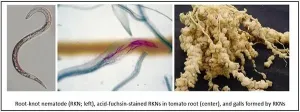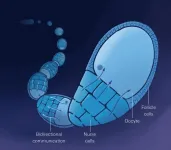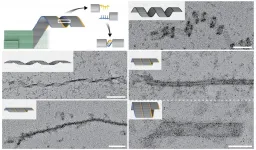(Press-News.org) Almost 90 percent of infectious travelers could be detected with rapid SARS-CoV-2 tests at the airport, and most imported infections could be prevented with a combination of pre-travel testing and a five-day post-travel quarantine that would only lift with a negative test result, according to a computer simulation by UC San Francisco researchers.
The study offers much-needed data to airlines and states that have struggled through a year of the pandemic with little guidance on how to enable safe travel.
The issue is becoming more pressing as states reopen and travelers return to the skies. Data from the Transportation Security Administration show that air travel has been on the rise since the 2020-2021 holiday season, although it is still only one-third to one-half of what it was before the pandemic.
"This evidence could be useful to standardize testing and quarantine policy for COVID-19 at the airline, city and state level for travelers," said Nathan Lo, MD, PhD, a resident physician and incoming faculty fellow in infectious diseases at UCSF and senior author of the paper, which was published March 22, 2021, in The Lancet Infectious Diseases. "Nothing will be perfectly safe, and travel will always pose a risk to the individual and for importation to states, but this is a way to substantially minimize the risk."
The data in the study come from a large-scale computer simulation of how different combinations of testing and quarantine can prevent infectious travelers from spreading COVID-19. The model makes forecasts based on what is already known about how many people are likely to be infected on any given day, how long they are likely to be infectious and how likely different types of tests are to detect infectious people.
The study simulated the probability that 100,000 travelers would be infectious on any given day shortly before, during and after their trips, given a range of different pre-travel testing and post-travel quarantine-plus-testing strategies.
"We know from the published literature how the infection spreads, and we can simulate how likely different testing and quarantine strategies will be to protect a person from infection, and also reduce their chance of being a source of transmission in the community," Lo said.
The study found that PCR-based testing three days before departure or rapid testing at the airport both reduced the number of infectious travelers by almost 90 percent, while imposing a five-day quarantine that could only be lifted with a negative PCR test, reduced the number of "infectious days," or the days that travelers would be able to spread the virus, by two-thirds.
The simulated quarantine had an added benefit because it would catch people who tested negative before departure but were actually infected. People may test negative at the early stages of infection and only turn positive on a test several days later. The quarantine would prevent those people from spreading the virus in the days after they arrived at their destination.
The scientists were impressed to find that rapid tests like the Abbott BinaxNOW antigen test administered to travelers on the day of travel were about as effective in the simulations as the gold-standard PCR prior to travel. They noted, however, that many rapid tests perform poorly and that the study's results were only applicable if a rapid test performed as well as those like the Abbott BinaxNOW, which has been studied at UCSF and found to be reliable.
"It is reasonable to assume the more sensitive PCR would be the most useful," said Mathew Kiang, ScD, a fellow at the FXB Center for Health and Human Rights at the Harvard TH Chan School of Public Health, first author of the paper. "But here we saw that the same-day rapid testing was almost as good after accounting for the delay in test results from a PCR."
He added that the rapid tests have the advantage of being a quick and easy alternative for travelers, whereas PCR tests require them to make an additional trip to get tested a few days before departure.
"Asking people to get tested before the day of travel may not be as feasible," he said.
Researchers also found that a five-day quarantine was about as effective as a 10- or 14-day quarantine, and also more likely to be enforceable.
One of the key implications of the study is the extent to which requiring a negative test before travel, as well as five days after travel, can reduce the importation of infections from high-risk areas to low-risk areas, thus controlling the spread of the pandemic.
"Ultimately, it's a value judgment," Lo said. "These strategies are not perfect, but if we implement test-and-travel strategies, we can dramatically reduce the risk of infection when traveling."
INFORMATION:
Authors: Joining Lo and Kiang in the study were Lloyd Chapman, PhD, Isabel Rodríguez-Barraquer, MD PhD, Bryan Greenhouse, MD, George Rutherford, MD, Kirsten Bibbins-Domingo, MD PhD, and Diane Havlir, MD, all of UCSF; Elizabeth Chin and Benjamin Huynh, of Stanford University; and Sanjay Basu, MD, PhD, of Harvard Medical School.
Funding: The study was supported by the UCSF Department of Medicine.
Disclosures: None.
About UCSF: The University of California, San Francisco (UCSF) is exclusively focused on the health sciences and is dedicated to promoting health worldwide through advanced biomedical research, graduate-level education in the life sciences and health professions, and excellence in patient care. UCSF Health, which serves as UCSF's primary academic medical center, includes top-ranked specialty hospitals and other clinical programs, and has affiliations throughout the Bay Area. Learn more at https://www.ucsf.edu, or see our Fact Sheet.
Follow UCSF
ucsf.edu | Facebook.com/ucsf | YouTube.com/ucsf
Root-knot nematodes (RKNs, Meloidogyne spp.) infect a broad range of plants, including several agriculturally important species such as cotton, soybean and corn, as well as various vegetables and ornamentals. These parasites cause roots to develop galls that result in severe plant damage and, ultimately, important crop losses. Growers currently use synthetic nematicides to manage RKNs; however, these compounds are detrimental to the microbial diversity of soil and harmful for the environment. Thus, it is necessary to develop alternative sustainable control methods.
"We have been seeking natural compounds that activate plant defense ...
A team of scientists at the University of Massachusetts Amherst have developed the thinnest and most sensitive flow sensor, which could have significant implications for medical research and applications, according to new research published recently in Nature Communications.
The research was led by Jinglei Ping, assistant professor of mechanical and industrial engineering, along with a trio of mechanical engineering Ph.D. students: Xiaoyu Zhang, who fabricated the sensor and made the measurement, Eric Chia and Xiao Fan. The findings pave the way for future research on all-electronic, in-vivo flow monitoring in investigating ...
A cast of so-called 'nurse cells' surrounds and supports the growing fruit fly egg during development, supplying the egg -- or 'oocyte' -- with all the nutrients and molecules it needs to thrive. Long viewed as passive in this process, the Drosophila egg actually plays an active role not only in its own growth, but also in the growth of the surrounding nurse cells, Princeton University researchers report on March 21 in Developmental Cell.
"Here we show an example of bidirectional communication -- a dialogue -- between different cells. The egg is taking an active hand in controlling its own feeding ...
Scientists from the Department of Physiology of the University of Granada (UGR) have shown that caffeine (about 3 mg/kg, the equivalent of a strong coffee) ingested half an hour before aerobic exercise significantly increases the rate of fat-burning. They also found that if the exercise is performed in the afternoon, the effects of the caffeine are more marked than in the morning.
In their study, published in the Journal of the International Society of Sports Nutrition, the researchers aimed to determine whether caffeine--one of the most commonly-consumed ergogenic substances in ...
LAWRENCE -- When a franchise buys a superstar like Tom Brady or LeBron James, the team tends to win more games. But do the fans follow? How much team loyalty is purchased along with an expensive star? Maybe not as much as some owners might hope -- in the NBA Finals between the Miami Heat and San Antonio Spurs, many fans expressed their dislike of the "bought" Miami team.
In a new paper published in the peer-reviewed Journal of Applied Social Psychology, researchers at the University of Kansas asked over 1,500 Americans how much they liked teams that purchased excellence and compared that with liking teams that built excellence from the ground up.
"People reliably ...
An international team of scientists from Nanyang Technological University, Singapore (NTU Singapore), Brown University and the Massachusetts Institute of Technology (MIT) has developed an artificial intelligence (AI) platform that could one day be used in a system to assess vascular diseases, which are characterised by the abnormal condition of blood vessels.
The AI-powered platform combines machine learning and a specially-designed microfluidic chip with analysis of 2D video images of blood flow and the application of physical laws, to infer how blood flows in 3D. In tests, it accurately predicted blood flow characteristics such as speed, pressure, and shear stress, ...
The world needs more electricity. As populations grow, standards of living increase and more people gain access to modern conveniences, countries will need to expand their energy generation capacity.
India, with its rapidly developing economy and a population of more than 1.3 billion, epitomizes this trend. The country finds itself at a crossroads regarding its energy future: Small decisions today will resound in the coming years.
In their latest report, the Indian government set a target of 450 gigawatts of renewable energy capacity by 2030. For comparison, the country's total energy generation capacity today is about 380 gigawatts, out of which 90 gigawatts are of renewable energy, not including large hydropower stations. How this plan shapes up will dictate how ...
(BOSTON) -- A team of nanobiotechnologists at Harvard's Wyss Institute for Biologically Inspired Engineering and the Dana-Farber Cancer Institute (DFCI) led by Wyss Founding Core Faculty member William Shih, Ph.D., has devised a programmable DNA self-assembly strategy that solves the key challenge of robust nucleation control and paves the way for applications such as ultrasensitive diagnostic biomarker detection and scalable fabrication of micrometer-sized structures with nanometer-sized features. Using the method, called "crisscross polymerization", the researchers can initiate weaving ...
One of the surest signs of spring is the vibrantly lime-green tinge trees develop as their buds open and tiny new leaves unfurl. Bud-break is the scientific name for this process -- a straightforward term for the grand genetic mechanism that allows trees to leaf out and do their summer work of photosynthesis to store up energy for the coming winter.
Bud-break is precluded by bud-set, which occurs in the autumn. After trees have dropped their leaves and as the days shorten and grow colder, new buds grow on branches. Like many wildflowers, trees require a period of dormancy at colder temperatures -- a process fine-tuned by evolution ...
DURHAM, N.C. -An unfortunate biological "feed-forward" loop drives cartilage cells in an arthritic joint to actually contribute to progression of the disease, say researchers at Duke University and Washington University in Saint Louis.
Pain researcher and mechanobiologist Wolfgang Liedtke, a professor of neurology at Duke, partnered with former Duke colleague and cartilage expert Farshid Guilak, now at the Washington University School of Medicine, to examine the activity of pressure-sensitive ion channels in cartilage. Their study appears the week of March 22 in the Proceedings of the National Academy of Sciences.
Cartilage is the highly lubricated, low-friction, elastic tissue that lines ...





